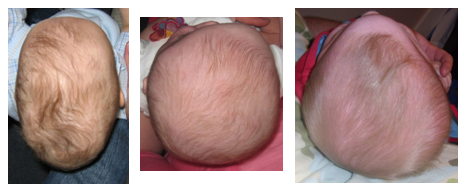Spotting the Signs of Craniosynostosis
Craniosynostosis is a rare condition seen in approximately one in 3,300 live births and characterised by an abnormal head shape. If left untreated it can affect the development of the brain so it’s important to catch it as early as possible. This article will help you spot the signs of craniosynostosis so you know what to look out for.
N.B. This is for information purposes only and should by no means be treated as a diagnostic tool. If you think your baby might have craniosynostosis, arrange an appointment with your GP and they will be able to put your mind at rest.
Signs of craniosynostosis
The most obvious sign of craniosynostosis is an abnormal head shape, like those shown in the photographs below.
 Craniosynostosis is easily confused with flat head syndrome, a far more common and relatively benign condition also characterised by a misshapen head.
Craniosynostosis is easily confused with flat head syndrome, a far more common and relatively benign condition also characterised by a misshapen head.
But while flat head syndrome has no confirmed effect on development and is easy to treat in most cases, craniosynostosis is more severe and requires surgery in order to be corrected.
The condition involves a premature fusion of one or more of the sutures (the seams between the bony plates in the skull). Unless carefully managed, this can restrict brain growth and lead to developmental deficiencies.
Flat head syndrome, on the other hand, is believed to be a largely cosmetic and relatively harmless condition, and results in a noticeable but reversible head shape deformity.
Differentiating between craniosynostosis and flat head syndrome
It can be very difficult to tell the difference between craniosynostosis and flat head syndromes such as plagiocephaly and brachycephaly, and diagnosis should only be undertaken by an expert. However, three telltale signs of craniosynostosis in babies include:
- A hardened ridge along the sutures
- Disproportionate growth of the head compared with the rest of the body
- The fontanelles (the soft spots between the plates in the skull) may feel different to normal or seem to have disappeared
The infant may also experience intercranial pressure (ICP), although this may not become noticeable until later on in childhood.
This is where pressure builds up in the brain as a result of the irregular shape of the skull, resulting in persistent headaches, visual problems and a sudden decline in academic ability.
Further down the line, ICP can cause vomiting, irritability, unresponsiveness, swelling of the eyes and difficulty breathing and hearing.
What to do if you think your baby might have craniosynostosis
If your baby has a misshapen head, it’s important to get this checked out by a doctor as soon as possible to rule out craniosynostosis.
In the meantime, it may be easier said than done but try not to worry. Craniosynostosis only affects around one in 100 infants with a severe head shape deformity, so even if your baby’s head looks alarmingly misshapen, this is most likely to be a cosmetic and easily treatable condition.
If the deformity turns out to be flat head syndrome, this can easily be reversed though special ‘repositioning’ techniques or, in moderate and severe cases, by means of a specially made helmet or ‘cranial orthosis’.
These helmets are not currently available on the NHS, but there are a number of private clinics that offer specialist treatment for babies with flat head syndrome.
Technology in Motion is one of the UK’s best respected providers of such treatment and has treated thousands of babies during the company’s 10 years in practice.
Call 0330 100 1800 to book an appointment at your nearest clinic, or visit www.technologyinmotion.com for more information on the company and the service that they offer.
